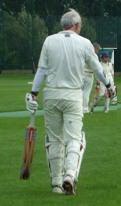Man 1 And I say it just ain't right. Rain comes down and t'side wi' fewer runs wins.
Man 2 Yes, but they'd had fewer overs to score 'em than t'other team.
Man 1 Ay, but they'd lost more wickets. Vera, love, what d'ye think?
Vera Well m'ducks, it's all pretty simple to me. You've to reckon that each team should be taken to have two resources to use to make as many runs as possible: the number of overs; and the number of wickets they have in hand. At any point a team's ability to score more runs depends on the combination of these two resources. Pint of bitter, love? One pound fifty.
She interrupts her discourse to serve a customer and then returns.
Vera Now, as I were saying, looking at historical scores, there is a very close correspondence between the availability of these resources and a team's final score. For meself, I think they should publish a table or summat which gives the percentage of these combined resources remaining for any number of overs (or, more accurately, balls) left and wickets lost. If it were up to me like I'd think a target score or summat could be adjusted up or down to reflect the loss of resources to one or both teams when a match is shortened one or more times. This percentage is then used to calculate a target that is usually a fractional number of runs. If the second team passes the target then the second team is taken to have won the match. That's what I'd be thinking,if anyone were to ask like. Now what could be simpler? Same again is it, gents?
She turns away.
Man 2 Aye she's a grand lass that Vera Duckworth.
Man 1 Aye - a grand lass but she doesn't know the first thing about cricket.
 |
| They should publish a table or summat |
Whatever its origins, the D/L method was adopted by the International Cricket Council (ICC) in 1999 to address the problem of delayed one-day cricket matches for reasons of rain, poor light and floodlight failures although it has also been used in events that have been shortened due to crowd problem, sandstorms and even snowstorms. Those of the statistical bent can look here for full details - they will find all they need to pass the lonely evenings including tables and sample scorings.
For the less statistically minded, the Duckworth Lewis Method is also a rock band who issued a concept album in 2009. Listen here for one of the tracks from that album, Meeting Mr Miandad.


oh that is a nice tribute, and I would like we have more things like that, but in today's world, it is very difficult unfortunately
ReplyDelete